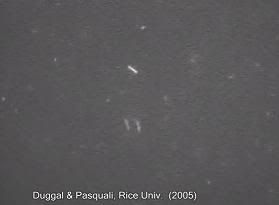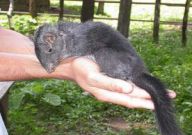Billionaire investor Warren Buffett has said he was waiting for decades to make a huge charitable donation.  He said he was overjoyed as he spoke for the first time since revealing he would donate about $37bn (£20bn) to Bill Gates' charitable foundation.
He said he was overjoyed as he spoke for the first time since revealing he would donate about $37bn (£20bn) to Bill Gates' charitable foundation.
"This has been coming for 50 years," Mr Buffett said. "There's never really been any other plan in terms of where the money should go."
The donation is thought to be the largest charitable gift ever in the US.
Giving people a chance
Mr Buffett will hand 10 million shares in his Berkshire Hathaway firm to the Bill and Melinda Gates Foundation.
News of the donation comes shortly after Mr Gates announced he is to step away from his day-to-day role at software giant Microsoft.
The man known as "the sage of Omaha" for his relentless success in investments said he always wanted to give the bulk of his fortune away.
However, he said the appropriate vehicle for doing so do had only become apparent in the past year.
"I am not an enthusiast of dynastic wealth, particularly when the alternative is six billion people having that much poorer hands in life than we have, having a chance to benefit from the money," he said.
Mr Gates said it was Mr Buffett's support for philanthropy which had persuaded him to set up the foundation in the first place.
"It is a big challenge to make sure this money gets used in the right way," he said of the donation.
"But it is one we are thrilled about."
The foundation aims to fight disease and promote education around the world.
By July 2008 Mr Gates, the world's richest businessman, will concentrate on the foundation, which is currently worth just under $30bn.
BBC business editor Robert Peston said the size of the foundation's cash pile dwarfed that of other organisations, and compared it with the $12bn annual budget of the United Nations.
He added that the foundation was "an extraordinary new force in the voluntary sector".
New will
Mr Buffett is worth an estimated $44bn, according to Forbes magazine.
As well as donating to the Gates foundation, he also pledged shares for his three children and a substantial gift for a foundation named for his late wife, Susan Thompson Buffett.
All the gifts will be awarded yearly, with 5% of each donation passed on each year, it was announced.
"It is a big challenge to make sure this money gets used in the right way," he said of the donation.
"But it is one we are thrilled about."
The foundation aims to fight disease and promote education around the world.
By July 2008 Mr Gates, the world's richest businessman, will concentrate on the foundation, which is currently worth just under $30bn.
BBC business editor Robert Peston said the size of the foundation's cash pile dwarfed that of other organisations, and compared it with the $12bn annual budget of the United Nations.
He added that the foundation was "an extraordinary new force in the voluntary sector".
New will
Mr Buffett is worth an estimated $44bn, according to Forbes magazine.
As well as donating to the Gates foundation, he also pledged shares for his three children and a substantial gift for a foundation named for his late wife, Susan Thompson Buffett.
All the gifts will be awarded yearly, with 5% of each donation passed on each year, it was announced.
She explained that Mr Buffett's largesse eclipses the charitable donations of such well-known givers as John D Rockefeller and Andrew Carnegie.
Despite his huge wealth, Mr Buffett has modest tastes, is called a "cola and hamburger kind of guy", plays the ukulele, and still lives in the same house he bought in his home town of Omaha, Nebraska, in 1957.
Mr Buffett has stated that the death of his wife Susan was one of the reasons behind his donation to the Gates Foundation, because he had thought she would outlive him and handle the dispersal of his wealth.
Source, -BBC News
C-Ice, putting the Tea in THC. Marijuana tea to debut in UK health shops.
British health food shops will soon be offering customers iced cannabis tea, its Swiss distributor said.
Sold under the label "C-Ice Swiss Cannabis Ice Tea", the beverage contains five percent of hemp flower syrup and a tiny (0.0015 percent) quantity of THC, the active ingredient of marijuana.

Any ingredient that could put it in the drugs category has been removed and the tea will not lead to dependency.
But British anti-drug campaigners say that selling the tea is dangerous because it will give young people the impression that cannabis is commonplace.
The product was launched in Switzerland in 2003 and is already available in Austria, Germany, the Netherlands, Portugal and Spain.
Knowledge is the opiate of the scholar.
Neuroscientists at the University of Southern California have proposed a simple explanation for the pleasure of grasping a new concept: The brain is getting its fix. According to researcher Irving Biederman, the "click" of comprehension triggers a biochemical cascade that rewards the brain with a shot of natural opium-like substances.
Writing in American Scientist, Biederman suggests that in seeking knowledge, scholars are almost like junkies. "While you're trying to understand a difficult theorem, it's not fun," said Biederman, a professor of neuroscience. "But once you get it, you just feel fabulous."
Interestingly, Biederman says the brain's craving for a fix motivates humans to maximize the rate at which they absorb knowledge. He hypothesized that knowledge addiction has strong evolutionary value because mate selection correlates closely with perceived intelligence. Only more pressing material needs, such as hunger, can suspend the quest for knowledge, he added. And apparently, the same mechanism may be involved in the aesthetic experience, providing a neurological explanation for the pleasure we derive from art.
Biederman's theory was inspired by a widely ignored 25-year-old finding that mu-opioid receptors (binding sites for natural opiates) increase in density along the ventral visual pathway, a part of the brain involved in image recognition and processing. The receptors are tightly packed in the areas of the pathway linked to comprehension and interpretation of images, but sparse in areas where visual stimuli first hit the cortex. Biederman's theory holds that the greater the neural activity in the areas rich in opioid receptors, the greater the pleasure.
To test his theory Biederman used magnetic resonance imaging on human volunteers who were exposed to a wide variety of images. The research group found that strongly preferred images prompted the greatest MRI activity in more complex areas of the ventral visual pathway. The researchers also found that repeated viewing of an attractive image lessened both the rating of pleasure and the activity in the opioid-rich areas. In his article, he explains this familiar experience with a neural-network model termed "competitive learning."
In competitive learning (also known as "Neural Darwinism"), the first presentation of an image activates many neurons, some strongly and a greater number only weakly. With repetition of the image, the connections to the strongly activated neurons grow in strength. But the strongly activated neurons inhibit their weakly activated neighbors, causing a net reduction in activity. This reduction in activity, Biederman's research shows, parallels the decline in the pleasure felt during repeated viewing.
"One advantage of competitive learning is that the inhibited neurons are now free to code for other stimulus patterns," Biederman explained. This preference for novel concepts also has evolutionary value, he added. "The system is essentially designed to maximize the rate at which you acquire new but interpretable [understandable] information. Once you have acquired the information, you best spend your time learning something else. There's this incredible selectivity that we show in real time. Without thinking about it, we pick out experiences that are richly interpretable but novel."
Source, -University of Southern Califonia
Sticky to slick, New Material switches with a flick of the light.
 Researchers from Rensselaer Polytechnic Institute have created an "optically switchable" material that changes from sticky to slippery when exposed to ultraviolet (UV) light. Describing their work in the journal Angewandte Chemie, the chemists involved said that the material could have a wide variety of applications, from a protein filter for biological mixtures, to a tiny valve for "lab-on-a-chip" devices.
Researchers from Rensselaer Polytechnic Institute have created an "optically switchable" material that changes from sticky to slippery when exposed to ultraviolet (UV) light. Describing their work in the journal Angewandte Chemie, the chemists involved said that the material could have a wide variety of applications, from a protein filter for biological mixtures, to a tiny valve for "lab-on-a-chip" devices. Problems inherent in the lab process of bioseparation drove the researchers to develop the new material. In bioseparation, synthetic polymer membranes are used to filter specific proteins from complex liquid mixtures of biological molecules. But proteins often stick to these membranes, clogging up their pores and severely limiting their performance. "Chemists need an inexpensive way to clean these membranes while they are still in place, rather than periodically removing them from the application environment," researcher Georges Belfort explained. But currently the only cleaning options available involve expensive chemicals or labor-intensive procedures that result in significant down-time.
Switchable stickiness can solve this problem, says Belfort. "We asked ourselves, can one use light to help the proteins hop-on and hop-off? We have shown that when one changes light, the proteins don't stick as well," Belfort explained.
To create the new material, Belfort attached spiropyran molecules to a widely used industrial polymer, polyether sulfone. Spiropyrans are a group of light-switchable organic molecules that exist in a colorless, "closed" form under visible light, but switch to a reddish-purple, "open" form when exposed to UV light. This change leads to an alteration of the new material's polarity, or the chemical structure of its atoms. In switching from non-polar to polar, the material becomes less attractive to proteins that might stick to its surface. Exposing the material to UV light is like flipping a molecular switch, causing sticky proteins to detach from the surface and wash away in the liquid.
Not only is the switching mechanism uncomplicated, but so is the patented procedure required to graft spiropyran molecules to polyether sulfone. "We used a relatively simple two-step process that could be easily incorporated into a commercial manufacturing process," Belfort said. And it's not just bioseparation applications that will benefit. Belfort envisions a number of potential applications for the materials, ranging from new membranes for treating polluted water to the targeted release of drugs in the body. "The relative ease of this grafting and switching process suggests many industrial opportunities," Belfort said in conclusion.
Source, -Science a gogo
Cell phones excite brain activity, potentially positve results?
WASHINGTON (Reuters) - Cell phone emissions excite the part of the brain cortex nearest to the phone, but it is not clear if these effects are harmful, Italian researchers reported on Monday.
Their study, published in the Annals of Neurology, adds to a growing body of research about mobile phones, their possible effects on the brain, and whether there is any link to cancer.
About 730 million cell phones are expected to be sold this year, according to industry estimates, and nearly 2 billion people around the world already use them.
Of these, more than 500 million use a type that emits electromagnetic fields known as Global System for Mobile communications or GSM radio phones. Their possible effects on the brain are controversial and not well understood.
Dr. Paolo Rossini of Fatebenefratelli hospital in Milan and colleagues used Transcranial Magnetic Stimulation or TMS to check brain function while people used these phones.
They had 15 young male volunteers use a GSM 900 cell phone for 45 minutes. In 12 of the 15, the cells in the motor cortex adjacent to the cell phone showed excitability during phone use but returned to normal within an hour.
The cortex is the outside layer of the brain and the motor cortex is known as the "excitable area" because magnetic stimulation has been shown to cause a muscle twitch.
The researchers stressed that they had not shown that using a cell phone is bad for the brain in any way, but people with conditions such as epilepsy, linked with brain cell excitability, could potentially be affected.
"It should be argued that long-lasting and repeated exposure to EMFs (electromagnetic frequencies) linked with intense use of cellular phones in daily life might be harmful or beneficial in brain-diseased subjects," they wrote.
Full Article, -Reuters

 A new way to make plastics out of sugar could help reduce the world’s reliance on petroleum. The technique could ultimately allow industry to make plastics from high-fructose corn syrups or other plant materials.
A new way to make plastics out of sugar could help reduce the world’s reliance on petroleum. The technique could ultimately allow industry to make plastics from high-fructose corn syrups or other plant materials.  Bioengineers at Tufts University, who have been delving into silk's secrets for more than a decade, have created a new fusion protein that combines the toughness of spider-silk with the intricate structure of silica. Research leader David L. Kaplan, said the resulting nanocomposite could be used in medical and industrial applications, such as growing bone tissue. "This is a novel genetic engineering strategy to design and develop new 'chimeric' materials by combining two of nature's most remarkable materials - spider silk and diatom glassy skeletons that normally are not found together," he added.
Bioengineers at Tufts University, who have been delving into silk's secrets for more than a decade, have created a new fusion protein that combines the toughness of spider-silk with the intricate structure of silica. Research leader David L. Kaplan, said the resulting nanocomposite could be used in medical and industrial applications, such as growing bone tissue. "This is a novel genetic engineering strategy to design and develop new 'chimeric' materials by combining two of nature's most remarkable materials - spider silk and diatom glassy skeletons that normally are not found together," he added. Shedding light on a somewhat controversial subject, physicists from the G-Zero collaboration have found that strange quarks do indeed contribute to the structure of the proton. Their findings indicate that, as previous experiments had hinted, strange quarks in the proton's quark-gluon sea contribute to a proton's properties. The G-Zero collaboration is a multi-year experimental program designed to measure, through the weak force, the strange quark contribution to proton structure.
Shedding light on a somewhat controversial subject, physicists from the G-Zero collaboration have found that strange quarks do indeed contribute to the structure of the proton. Their findings indicate that, as previous experiments had hinted, strange quarks in the proton's quark-gluon sea contribute to a proton's properties. The G-Zero collaboration is a multi-year experimental program designed to measure, through the weak force, the strange quark contribution to proton structure.  All it takes is an optical microscope and a video camera to film carbon nanotubes being jostled by water molecules, researchers have found.
All it takes is an optical microscope and a video camera to film carbon nanotubes being jostled by water molecules, researchers have found. 



 A German/UK team has put the giant GEO 600 gravitational wave detector in a continuous observational mode.
A German/UK team has put the giant GEO 600 gravitational wave detector in a continuous observational mode. 






 Story:
Story:
 He said he was overjoyed as he spoke for the first time since revealing he would donate about $37bn (£20bn) to Bill Gates' charitable foundation.
He said he was overjoyed as he spoke for the first time since revealing he would donate about $37bn (£20bn) to Bill Gates' charitable foundation. 
 Researchers from Rensselaer Polytechnic Institute have created an "optically switchable" material that changes from sticky to slippery when exposed to ultraviolet (UV) light. Describing their work in the journal Angewandte Chemie, the chemists involved said that the material could have a wide variety of applications, from a protein filter for biological mixtures, to a tiny valve for "lab-on-a-chip" devices.
Researchers from Rensselaer Polytechnic Institute have created an "optically switchable" material that changes from sticky to slippery when exposed to ultraviolet (UV) light. Describing their work in the journal Angewandte Chemie, the chemists involved said that the material could have a wide variety of applications, from a protein filter for biological mixtures, to a tiny valve for "lab-on-a-chip" devices. A dog is seen with employees of Oracle Corp Japan at the company's office in Tokyo February 4, 2003. Millions of Americans believe pets on the job lower absenteeism and encourage workers to get along, according to the survey by the American Pet Products Manufacturers Association. (Toshiyuki Aizawa/Reuters)
A dog is seen with employees of Oracle Corp Japan at the company's office in Tokyo February 4, 2003. Millions of Americans believe pets on the job lower absenteeism and encourage workers to get along, according to the survey by the American Pet Products Manufacturers Association. (Toshiyuki Aizawa/Reuters) Archaeologists have discovered that 100,000-year-old shells found in Israel and Algeria were decorative beads. This suggests that modern human forms of behaviour, such as language, developed earlier than previously thought.
Archaeologists have discovered that 100,000-year-old shells found in Israel and Algeria were decorative beads. This suggests that modern human forms of behaviour, such as language, developed earlier than previously thought.  The location of the spider silk strands have been drawn on this image. Magnified images of a mite and bubbles attached to a strand are shown in boxes. The scale bar is 1 millimetre long. (Image: Science)
The location of the spider silk strands have been drawn on this image. Magnified images of a mite and bubbles attached to a strand are shown in boxes. The scale bar is 1 millimetre long. (Image: Science)


 The latest research on water - still one of the least understood of all liquids despite a century of intensive study – seems to support the possibility that cells, tissues and even the entire human body could be cyropreserved without formation of damaging ice crystals, according to University of Helsinki researcher Anatoli Bogdan, Ph.D
The latest research on water - still one of the least understood of all liquids despite a century of intensive study – seems to support the possibility that cells, tissues and even the entire human body could be cyropreserved without formation of damaging ice crystals, according to University of Helsinki researcher Anatoli Bogdan, Ph.D


 Maoist's model revolution, shows rest of world what works.
Maoist's model revolution, shows rest of world what works. 



 "A world lost for more than 100 million years was being revealed to us," -ABC NEWS
"A world lost for more than 100 million years was being revealed to us," -ABC NEWS



 The first pictures showing a live specimen of a rodent species once thought to have been extinct for 11 million years have been taken by a retired Florida State University professor and a Thai wildlife biologist. They took video and still photographs of the "living fossil," which looks like a small squirrel or tree shrew, in May during an expedition to central Laos near the Thai border.Known as Diatomyidae, scientists have nicknamed it the Laotian rock rat. The creature is not really a rat but a member of a rodent family once known only from fossils.The pictures show a docile, squirrel-sized animal with dark dense fur and a long tail but not as bushy as a squirrel's. It also shows that the creature waddles like a duck with its hind feet splayed out at an angle _ ideal for climbing rocks."I hope these pictures will help in some way to prevent the loss of this marvelous animal," said David Redfield, a science education professor emeritus.He and Uthai Treesucon, a bird-watching colleague, befriended hunters who captured a live rock rat after four failed attempts.
The first pictures showing a live specimen of a rodent species once thought to have been extinct for 11 million years have been taken by a retired Florida State University professor and a Thai wildlife biologist. They took video and still photographs of the "living fossil," which looks like a small squirrel or tree shrew, in May during an expedition to central Laos near the Thai border.Known as Diatomyidae, scientists have nicknamed it the Laotian rock rat. The creature is not really a rat but a member of a rodent family once known only from fossils.The pictures show a docile, squirrel-sized animal with dark dense fur and a long tail but not as bushy as a squirrel's. It also shows that the creature waddles like a duck with its hind feet splayed out at an angle _ ideal for climbing rocks."I hope these pictures will help in some way to prevent the loss of this marvelous animal," said David Redfield, a science education professor emeritus.He and Uthai Treesucon, a bird-watching colleague, befriended hunters who captured a live rock rat after four failed attempts.  Submitted by Rick Hamell: Israeli scientists said on Wednesday they had discovered a prehistoric ecosystem dating back millions of years. The discovery was made in a cave near the central Israeli city of Ramle during rock drilling at a quarry. Scientists were called in and soon found eight previously unknown species of crustaceans and invertebrates similar to scorpions."Until now eight species of animals were found in the cave, all of them unknown to science," said Dr Hanan Dimantman, a biologist at the Hebrew University of Jerusalem.He said the cave's ecosystem probably dates back around five million years when the Mediterranean Sea covered parts of Israel. The cave was completely sealed off from the world, including from water and nutrients seeping through rock crevices above.
Submitted by Rick Hamell: Israeli scientists said on Wednesday they had discovered a prehistoric ecosystem dating back millions of years. The discovery was made in a cave near the central Israeli city of Ramle during rock drilling at a quarry. Scientists were called in and soon found eight previously unknown species of crustaceans and invertebrates similar to scorpions."Until now eight species of animals were found in the cave, all of them unknown to science," said Dr Hanan Dimantman, a biologist at the Hebrew University of Jerusalem.He said the cave's ecosystem probably dates back around five million years when the Mediterranean Sea covered parts of Israel. The cave was completely sealed off from the world, including from water and nutrients seeping through rock crevices above.